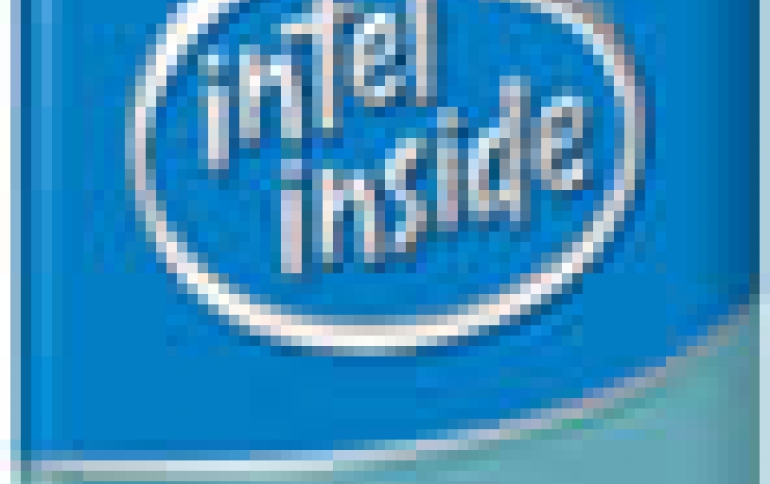
Intel Unveils Dual-core Xeon Processor
Intel on Monday officially took the wraps off the long-awaited dual-core version of its Xeon server processor. Xeon is claimed to be around 50 percent more powerful than its single-core predecessor, but it will cost around 40 percent more than that chip.
"The focus of this year has been on the transition to dual core," said Intel vice president
Stephen Smith at a press conference on Monday.
At the press event, Intel talked about two implementations of the dual-core Xeon that it's releasing. The first is intended for use in single-socket servers also known as "DP," or dual-processor, servers. Systems based on this device, which runs at a clock speed of 2.8 GHz, are available immediately from Hewlett-Packard and other vendors. The processor itself will sell for slightly more than $1,000.
The Dual-Core Xeon also comes with a power-management feature called demand-based switching, which turns off portions of the chip when not in use. It also comes with Intel's hyperthreading technology, allowing each core to process two independent software threads at the same time.
The second is billed as the Xeon 7000 sequence, and is the part formerly code-named Paxville. It's intended for use in so-called multiprocessing systems, which incorporate more than one dual-core part, and thus contain four or more CPU cores. The chip, which will be available in versions running at up to 3.0 GHz, will ship sometime in the next 60 days.
At the Monday press conference, Intel also reiterated its aggressive deployment plans for dual-core technology. "Over the first half of 2006, we'll continue the deployment of dual core server processors," Smith said. "[In the] second half of 2006, we have a refresh of the platform, based on our next generation micro-architecture."
These include promised parts code-named Woodcrest, Conroe, and Merom.
"We'll continue the progression in 2007," Smith added. "We expect to introduce our first four-core microprocessors. All the products we are developing in the Intel Architecture [i.e., x86] space are dual-core or muilti-core capable."
Smith said that Intel currently has 15 dual-core processors and an additional 10 multi-core processors under development.
On the desktop front, Intel is planning to extend both its dual-core Pentium D line and to update its current, top-of-the-line Pentium Extreme Edition 840 part in early 2006 with the Pentium Extreme Edition 955.
Dell, Hewlett-Packard and IBM have all announced support for the new Dual-Core Xeon, and customers interested in the product can order systems from all three vendors as of Monday.
As for AMD, which was first to market and continues to lead in sales of dual-core x86 server parts with its Opteron family, it hasn't been resting on its laurels. In September, AMD added three new processors. The Opteron Model 880 is intended for use in multiprocessing boxes swith up to eight of the dual-core chips, which would make for a 16-CPU system. The Model 280 can be fitted onto motherboards in pairs, and the Model 180 is for one-processor (two core) servers.
At the press event, Intel talked about two implementations of the dual-core Xeon that it's releasing. The first is intended for use in single-socket servers also known as "DP," or dual-processor, servers. Systems based on this device, which runs at a clock speed of 2.8 GHz, are available immediately from Hewlett-Packard and other vendors. The processor itself will sell for slightly more than $1,000.
The Dual-Core Xeon also comes with a power-management feature called demand-based switching, which turns off portions of the chip when not in use. It also comes with Intel's hyperthreading technology, allowing each core to process two independent software threads at the same time.
The second is billed as the Xeon 7000 sequence, and is the part formerly code-named Paxville. It's intended for use in so-called multiprocessing systems, which incorporate more than one dual-core part, and thus contain four or more CPU cores. The chip, which will be available in versions running at up to 3.0 GHz, will ship sometime in the next 60 days.
At the Monday press conference, Intel also reiterated its aggressive deployment plans for dual-core technology. "Over the first half of 2006, we'll continue the deployment of dual core server processors," Smith said. "[In the] second half of 2006, we have a refresh of the platform, based on our next generation micro-architecture."
These include promised parts code-named Woodcrest, Conroe, and Merom.
"We'll continue the progression in 2007," Smith added. "We expect to introduce our first four-core microprocessors. All the products we are developing in the Intel Architecture [i.e., x86] space are dual-core or muilti-core capable."
Smith said that Intel currently has 15 dual-core processors and an additional 10 multi-core processors under development.
On the desktop front, Intel is planning to extend both its dual-core Pentium D line and to update its current, top-of-the-line Pentium Extreme Edition 840 part in early 2006 with the Pentium Extreme Edition 955.
Dell, Hewlett-Packard and IBM have all announced support for the new Dual-Core Xeon, and customers interested in the product can order systems from all three vendors as of Monday.
As for AMD, which was first to market and continues to lead in sales of dual-core x86 server parts with its Opteron family, it hasn't been resting on its laurels. In September, AMD added three new processors. The Opteron Model 880 is intended for use in multiprocessing boxes swith up to eight of the dual-core chips, which would make for a 16-CPU system. The Model 280 can be fitted onto motherboards in pairs, and the Model 180 is for one-processor (two core) servers.





















